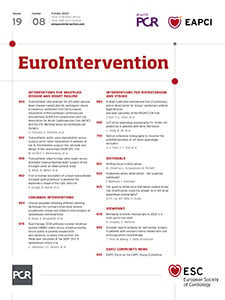The 2022 European Society of Cardiology (ESC)/European Respiratory Society (ERS) Guidelines for the management of pulmonary hypertension (PH) define PH as a mean pulmonary artery pressure (mPAP) of >20 mmHg at rest, as determined by an invasive measurement in the pulmonary arteries (PA)1. PH is a multifaceted disease and often an undetected cause of dyspnoea, fatigue, and loss of exercise capacity2. The prevalence of PH in the global population is about 1% and is continuously increasing3. According to the ESC/ERS and the World Health Organization (WHO), PH is classified and divided into 5 groups. PH Group 1 encompasses idiopathic or hereditary PH and PH associated with certain infectious and structural diseases (like systemic sclerosis or human immunodeficiency virus infection). Most commonly, however, the exact aetiology of PH Group 1 remains unknown, and the pathophysiology is incompletely understood. Consequently, treatment of PH Group 1 can be challenging.
Certain patients are eligible for medical therapy with phosphodiesterase 5 inhibitors (PDE-5i), soluble guanylate cyclase (sGC) stimulators, endothelin receptor antagonists (ERA), prostacyclin analogues, prostacyclin receptor agonists, and calcium channel blockers (CCB). These drugs mostly improve functional outcomes (e.g., exercise capacity) and symptom burden. Only epoprostenol and selexipag have been shown to reduce mortality in carefully selected PH Group 1 patients45. Hence, current guidelines recommend an initial combination therapy of ERA and PDE-5i with a class IIa recommendation1. Against this background, innovative alternative treatment strategies for PH Group 1 are needed. Catheter-based pulmonary artery denervation (PADN) is a novel approach aiming at decreasing the activity of the sympathetic nerve fibres in the perivascular space of the PAs, thereby reducing the vasotonus and, consequently, PA pressures (PAP). Preclinical and limited clinical evidence suggest that the ablation of sympathetic nerves surrounding the PAs can indeed lower elevated PAP678, but larger randomised, sham-controlled trials investigating PADN on top of pharmacotherapy are lacking.
In this issue of EuroIntervention, Kan et al report the 1-year outcomes from the first sham-controlled, randomised trial of radiofrequency PADN in addition to background therapy with PDE-5i in 128 patients with PH Group 19.
At the time of enrolment, patients were therapy-naïve and randomised to either medical treatment with a PDE-5i and PADN or medical treatment with a PDE-5i and a sham procedure. The 6-month data have previously been published and showed that PADN in combination with pharmacotherapy was more effective in reducing pulmonary vascular resistance, increasing the 6-minute walking distance (6MWD), improving right ventricular function and lowering N-terminal pro-brain natriuretic peptide levels than pharmacotherapy alone10. The authors now extend their previous findings by reporting the 12-month outcomes, which showed a reduction in clinical worsening and an improvement in 6MWD in the PADN group compared to the sham group (adjusted hazard ratio for clinical worsening: 0.17, 95% confidence interval [CI]: 0.05-0.60; p=0.006; between-group change for 6MWD: 81.2 m, 95% CI: 50.3-112.2; p<0.001).
These data suggest that the treatment effects following PADN might subsist for at least 12 months, as clinical worsening occurred less often and 6MWD was improved in the PADN group compared with the sham group. The authors are to be congratulated for conducting this randomised, multicentre, sham-controlled trial, even more so because recruitment was performed during the COVID-19 pandemic. This trial is the first of its kind and provides interesting information for the treatment of PH, which has historically been debilitating and limited. While interpreting the long-term outcomes of the study, however, some limitations and open questions should be taken into account. First, the primary outcome, which initially was clinical worsening, was modified during the active phase of the trial and, after 12 months, did not include the 6MWD but WHO functional capacity instead. The authors state that this change was due to logistical challenges which occurred during the COVID-19 pandemic and prevented patients from travelling to the hospital for follow-up examinations. The trial was initially designed to detect a difference in the 6MWD and was not powered for clinical outcomes. Hence, the present long-term results should be regarded as hypothesis-generating10. Second, selection bias may have occurred because only patients with PH but without PH-specific drug treatment â likely because of logistical challenges or cost constraints â were included. Third, in close to 30% of the patients, follow-up assessment was done remotely (by telephone calls), and therefore, not all patients were thoroughly investigated at the long-term follow-up. Fourth, backgound medication was administered in an open-label fashion, changed according to physician’s discretion without a standardised protocol and did not (in all cases) comply with current guidelines. Fifth, the overall event rate was much lower than expected in a population of PH Group 1 patients.
PADN may represent an additive treatment approach for certain patients with PH Group 1 and concomitant medical therapy. However, important questions remain elusive and should be addressed by future studies: what are the most appropriate clinical outcomes to prove the efficacy of the procedure? Does anatomical and/or functional reinnervation occur at long-term follow-up? Can the technique and technology of PADN be revised to reduce variability or increase treatment effects? Which characteristics help identify patients with a high likelihood of response to PADN? Until then, the suspense continues.
Conflict of interest statement
F. Mahfoud is supported by Deutsche Gesellschaft für Kardiologie (DGK), Deutsche Forschungsgemeinschaft (SFB TRR219, Project-ID 322900939), and Deutsche Herzstiftung. He has received scientific support from Ablative Solutions, Medtronic, and ReCor Medical; and speaker honoraria/consulting fees from Ablative Solutions, Amgen, AstraZeneca, Bayer, Boehringer Ingelheim, Inari, Medtronic, Merck, ReCor Medical, Servier, and Terumo. F. Götzinger is supported by Deutsche Herzstiftung and has received speaker honoraria from AstraZeneca.

